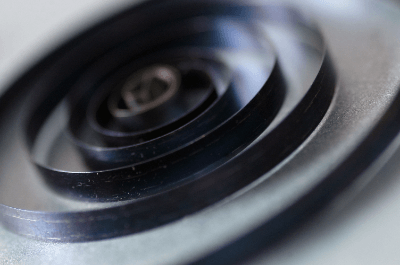What Is a Spiral Spring?

A Spiral Spring is a type of spring with twisted windings.
Spiral Spring has coils wound in a spiral shape, and when a force is applied, the energy is stored and released. Then, when it is repelled by a force such as a push or a pull, motion is generated, which is extracted and used to control the mechanism.
When properly designed and manufactured with the appropriate materials, this material has excellent strength and durability characteristics. It is possible to maintain stable elastic properties over a long period of time.
It is a relatively compact spring, and is often considered when there is little space to incorporate it in the design of a mechanism.
Applications of Spiral Spring
1. Vehicle Suspension
Spiral Springs are sometimes used in vehicle suspension systems. They are incorporated into the suspension to absorb vehicle vibrations and improve ride comfort. They absorb and release forces between the wheels and the body of the vehicle to reduce impact while driving.
2. Industrial Machinery
They are used in industrial machinery to absorb and control vibrations, align parts, and cushion them. They help control vibrations that occur during machine operation and help maintain accurate operation.
3. Consumer Products
Spiral Springs are also used in consumer products. Examples include door closers, shock absorbers, and keyboard key touches. Their purpose is to cushion and absorb vibration. They have also been commonly used in the cord winding mechanism of cord vacuum cleaners for many years.
4. Watches
Also used in wristwatches. A Spiral Spring powers a watch when the force is released from the wound state. Spiral Springs are often used in watches and clocks where space is at a premium, as they can be compactly assembled into a spring.
5. Household Goods
Spiral Springs are also used in many familiar household items, such as furniture cushions, automatically door-closing devices, and toys. They are also almost always used in the winding mechanisms of convex and tape measures.
Principles of Spiral Spring
1. Hooke’s Law
Hooke’s law states that there is a proportional relationship between the force a spring receives and its extension or compression. The force received by a spring is proportional to its spring constant and displacement. This principle applies to springs in general and was discovered by a scientist named Hooke.
2. Accumulation and Release of Elastic Energy
When a Spiral Spring is deformed by a force, energy is accumulated inside the spring. This stored energy is released when the spring is released. The Spiral Spring uses this energy to return to its original shape. The general principle of a spring is to control the mechanism by extracting the spring’s movement at this time.
3. Periodicity and Oscillation
When a periodic force is applied to a Spiral Spring, the spring accumulates and releases energy each time. The response results in periodic motion and vibration. This makes it possible to realize vibrations at specific frequencies and amplitudes.
Spiral Springs are used in a wide variety of applications, from everyday use to industrial, because they can be compactly constructed using this general principle of springs.
How to Select a Spiral Spring
First, the load requirements of the spring must be chosen with the appropriate load range in mind. The required range of extension and compression of the Spiral Spring is also an important factor.
Then, the appropriate spring constant is determined for the design conditions. The spring constant is a measure of the degree of deformation of a Spiral Spring. The larger the spring constant, the smaller the elongation or compression for the same force.
Material affects durability, strength, corrosion resistance, etc. We select the appropriate material for the application and environment, and consider whether or not it is cost-effective based on these overall factors.